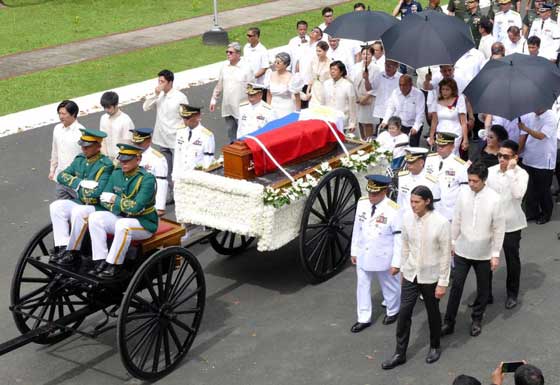THERE was no state funeral, but Friday’s surprise interment of the late strongman Ferdinand Marcos, whose Martial Law regime continues to divide the nation, had all the trappings of it.
In public, the Marcoses said it would only be a soldier’s funeral, but on Saturday, media people who were let in to the Libingan ng mga Bayani – after being barred from covering the burial the day before – saw the Marcos-era presidential seal emblazoned on the black marble tomb.
The Marcoses also scored another coup with Friday’s media ban – by posting videos and photos of the event exclusively on their Facebook pages, they were somewhat able to control their public image and send the message that they are back on the reins of power.
In one video posted on the Facebook page of Ilocos Norte Gov. Imee Marcos, the late strongman’s eldest daughter, the opening shot showed a military helicopter bringing Marcos’ remains to the national shrine for heroes in Taguig.
On social media (and not on television), netizens witnessed a half-kilometer funeral procession, with military generals leading a brigade of soldiers to the Libingan’s rotunda, where the Philippine flag flew half-mast for the veteran of the Bataan Death March during World War 2.
Behind the generals was the caisson bearing the pine casket that contained Marcos’ remains, pulled by the “white carabao” or military jeep used by presidents for trooping the line.
The former president was given the volley of fire and a flower drop, and the bugler sounded the last taps as the casket was slowly lowered to a crypt.
“It was my father’s fervent wish that when he came to the end of his days, that he be buried in a simple soldier’s ceremony. This was in keeping with his idea that he was but a soldier doing his duty, a citizen serving his country,” said Marcos’ son and namesake, former senator Ferdinand “Bongbong” Marcos Jr., in a message to the mourners.
“We have waited 27 years to fulfill that wish that he left us with. But we are here today and we are able to grant him that wish.”
The Marcos family, led by former first lady Imelda Marcos, looked liked they were the first family again. Imelda, clutching a rosary, was the only one who wore formal black, while the Marcos children and grandchildren wore resplendent white barongs and gowns.
To drive home the message, they left an “eternal flame” near the tomb, like the one at the gravesite of US President John F. Kennedy in Arlington National Cemetery.
But while they were able to pull off the burial that had been denied them by Marcos’ successors – with the help of a family friend, President Rodrigo Duterte who sent flowers to the Libingan – it angered human rights groups, opposition politicians and even millennials who did not witness Marcos’ one-man rule.
On Friday, hundreds of protesters converged at the monument on EDSA erected to commemorate Marcos’ overthrow by the “People Power” revolt in 1986.
“It was a Pyrrhic victory [for the Marcoses]. It only reopened old wounds, restarted the anti-Marcos movement, and transferred this to the millennial generation,” political analyst Ramon Casiple, executive director of the Institute for Political and Electoral Reforms, said in an interview.
Military spokesman Brig. Gen. Restituto Padilla was quick to clarify that the Marcoses would foot the bill for all expenses incurred beyond the standard funeral service for military men.
And it was not a state funeral, as there was no official state representative.
For Casiple, however, Imee’s Facebook videos showed otherwise.
“It was more than a soldier’s burial, less than a state funeral,” he stated. “Use of helicopters, 5,000 troops, 21-gun salute and elaborate protocols means no ordinary soldier’s burial.”
Martial Law victim Princess Nemenzo, 78, said the late strongman has no right to be laid to rest beside former presidents, national artists and heroes of war.
“We’re crying in anger. Because we Martial Law victims continue to feel the sufferings we had experienced,” she said during a protest in Quezon City. “That period of our history is a dark chapter and we don’t want it forgotten.”


